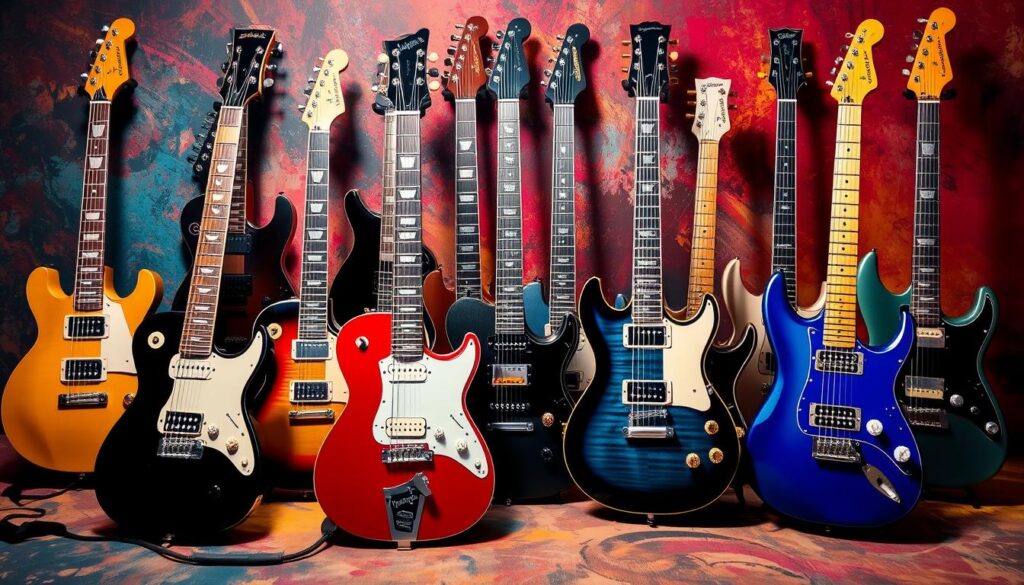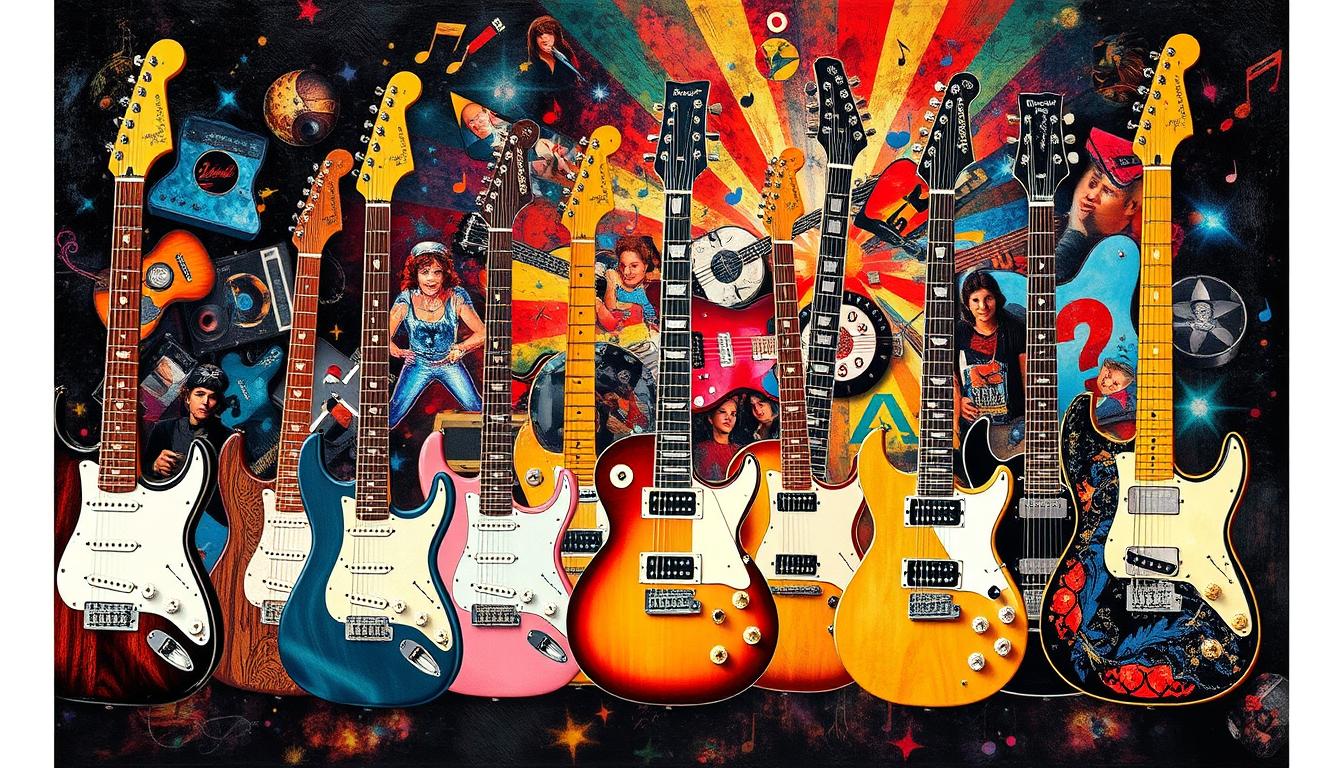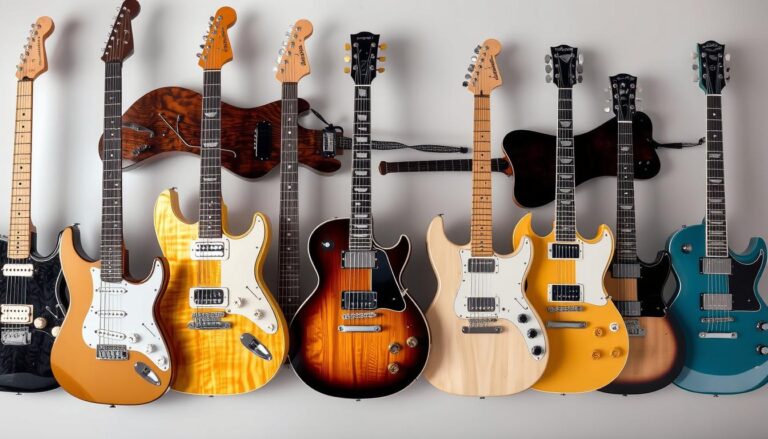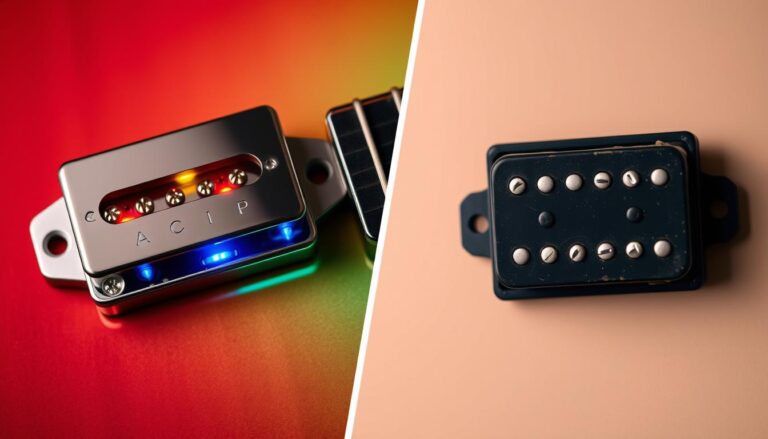Did you know the electric guitar was invented in 1931 by George Beauchamp? He created the “frying pan” guitar, starting the electric guitar’s journey. This innovation changed the music world forever! The need for louder sound led to the electric guitar’s creation, marking a significant milestone in music history.
At Superstar Soundz, we love providing top-notch audio-visual solutions. We think knowing the electric guitar’s history is key to understanding its role in music today. From the first coil pickups to today’s rock music icons, the electric guitar’s story is one of constant improvement. We’re excited to share this journey with you!
We’ll look at the electric guitar’s major milestones, like the Gibson ES-150 in 1936 and Les Paul’s solid-body guitars. These innovations changed music forever. They show how human creativity and the need for louder sounds have shaped the electric guitar’s history. We’re honored to be part of this legacy.
Key Takeaways
- The electric guitar was invented in 1931 by George Beauchamp, marking the beginning of the history of electric guitars.
- The origins of the electric guitar were driven by the need for amplified sound, which has been a key factor in shaping the history of electric guitars.
- Continuous innovation has been a hallmark of the electric guitar market, with ongoing developments in pickup materials, designs, and combinations.
- The solid-body electric guitar, introduced by Les Paul and Fender, has become a staple of rock music and has had a significant impact on the music industry.
- Understanding the history of electric guitars is essential to appreciating their impact on music today and the origins of the electric guitar.
- The electric guitar has come a long way, with designs like hollow body, semi-hollow body, and solid body. Each has its own features and uses.
- The history of electric guitars is a story of collaboration and innovation, with many pioneers contributing to its development and shaping the origins of the electric guitar.
The Origins of the Electric Guitar
The story of the electric guitar is both fascinating and complex. It involves many innovators. Knowing the electric guitar evolution helps us understand its current role and uses. The timeline of electric guitars shows a journey starting in the late 19th century. Musicians wanted to solve the volume problems of acoustic guitars.
Early Acoustic Instruments and Their Limitations
Acoustic guitars couldn’t project sound well, leading to the search for amplification. The first electric guitars were made to solve these issues. Pioneers like Adolph Rickenbacker and George Beauchamp were key in their development.
The Need for Amplification
The need for louder sounds drove the electric guitar’s creation. As music scenes and venues grew, so did the need for louder instruments. The Fender Telecaster, a solid-body electric guitar, changed the music world. Musicians like Jimi Hendrix and Eric Clapton explored new sounds and techniques.
The timeline of electric guitars shows our drive for innovation and creative expression. As we explore the electric guitar’s history, we’ll look at the impact of famous musicians and makers. They’ve shaped the instrument into what it is today.
The Invention of the Electric Guitar
George Beauchamp was a key figure in the electric guitar’s history. He worked with Adolph Rickenbacker to create the first electric guitar in the early 1930s. Their collaboration marked a new era in music.
The Rickenbacker Fry-Pan was the first electric guitar to succeed in the market. It was nicknamed the “frying pan” guitar. This design was patented in 1937, opening doors for more innovations. Famous models like the Rickenbacker Fry-Pan have greatly influenced music.
The Role of Innovators
Seth Lover introduced the humbucker pickup in 1955, a major step in electric guitar design. Gibson and Les Paul worked together to create the Gibson Les Paul in the 1950s. This was another big leap in electric guitar history.
Some famous electric guitar models include:
- Rickenbacker Fry-Pan
- Gibson Les Paul
- Fender Stratocaster
These guitars have been favorites of many famous musicians. They have helped shape many music genres.

The early guitars’ impact on music will be explored. We will look at the history of electric guitars. We will highlight the innovators and famous models that have shaped music.
| Model | Year | Innovator |
|---|---|---|
| Rickenbacker Fry-Pan | 1930s | George Beauchamp and Adolph Rickenbacker |
| Gibson Les Paul | 1950s | Les Paul and Gibson |
| Fender Stratocaster | 1954 | Leo Fender |
The Birth of the Solid Body Electric Guitar
The journey of electric guitar development has been amazing, with key moments that changed music. The solid-body electric guitar was a big step, changing how guitars sound and play. Famous models like the Fender Telecaster and Gibson Les Paul have become symbols of rock and roll.
Les Paul, a famous musician and inventor, was key in making the solid-body electric guitar. His work with solid wood and electronics led to the “log” guitar, an early version of today’s solid-body guitars. The Fender Telecaster, introduced in 1951, made solid-body guitars even more popular in music.
Solid-body guitars have less feedback and hold notes longer than hollow-body ones. This makes them a favorite for rock, blues, and country players. As we dive deeper into electric guitar history, we see how they’ve changed music and the role of innovators like Les Paul. Check out our blog at https://superstarsoundz.com/blog/ for more on electric guitar history.
The table below shows important moments in solid-body electric guitar history:
| Year | Model | Innovator |
|---|---|---|
| 1940 | Log Guitar | Les Paul |
| 1951 | Fender Telecaster | Leo Fender |
| 1952 | Gibson Les Paul | Les Paul and Gibson Guitars |
The effect of electric guitars on music is clear, and their evolution keeps changing music today. Looking ahead, it’s thrilling to think about what new things will come in electric guitar technology.
The Rise of the Popular Electric Guitar
The electric guitar’s role in rock and roll is huge. Players like Chuck Berry and Jimi Hendrix made it famous. They brought new sounds and styles that won fans all over.
Rock and roll made electric guitars very popular. Sales jumped by 400% from 1958 to 1965. In 1965, 1.5 million guitars were sold. This rise was thanks to legendary players who made music exciting.
Some famous electric guitar players are:
- Chuck Berry, known for his unique riffs and stage presence
- Jimi Hendrix, famous for his bold and creative playing
- Eric Clapton, a big influence in blues and rock
Electric guitars are key in today’s music too. Many artists use them to make new sounds. The electric guitar’s impact on music will last for many years.
Evolution of Electric Guitar Technology
Electric guitars have seen big changes over the years. Famous models have always been at the forefront of new ideas. These changes include better pickups and new materials.
The first electric guitar, the Rickenbacker “Frying Pan,” came out in 1931. Then, in 1948, the Fender Broadcaster, now known as the Telecaster, was introduced. These guitars set the stage for today’s electric guitars, with their special designs.
Improvements in pickups have let musicians play a variety of sounds. New materials, like Bakelite in the 1935 Rickenbacker “Electro String,” have also played a role. Now, we have many famous electric guitars, each with its own look and sound.
The electric guitar is always getting better, shaping the music world. New designs keep coming, making us excited for what’s next. It’s thrilling to think about how these guitars will keep changing music.
The Role of Amplifiers in Electric Guitar History
Exploring the electric guitar’s history shows how important amplifiers are. They greatly changed the sound of electric guitars. In the beginning, amplifiers were not very good. Musicians used “radio horns of limited frequency range and low acoustic output” as speakers.
The 1930s brought cone speakers and the first AC mains-powered amplifiers in 1927. These changes helped musicians make a louder, clearer sound. This greatly affected the music industry.
Early Amplifiers and Their Development
Early amplifiers were weak, often at 15 watts or less until the mid-1950s. The first dedicated electric guitar amplifier was made in 1932 by Electro String. These early amps used 10-watt speakers, which were not enough for electric guitar players.
Modern Amplifier Technology
Now, amplifiers are much more powerful and varied. Modern tech lets musicians create many sounds, from clean to distorted. Famous musicians use electric guitars to make their unique sounds.
Important changes in amplifiers include Leo Fender’s 50-watt amps in 1949 and Jim Marshall’s 100-watt amps in the 1960s. These changes helped electric guitars sound loud and clear. This has been key to their impact on music.
The Electric Guitar in Various Music Genres
The electric guitar is key in many music styles, like jazz, blues, and country. It’s vital for making new sounds. Famous players, such as Eddie Durham and Les Paul, have shaped these genres.
Jazz and the Electric Guitar
In jazz, the electric guitar makes complex sounds. Jazz musicians have explored its limits. It’s loved for its wide range of tones and textures.
The Electric Guitar in Blues and Country Music
In blues and country, the electric guitar adds energy. B.B. King and Jimi Hendrix used it to make unforgettable music. Its role shows its versatility and ability to express.
The electric guitar’s role in music genres shows its value and flexibility. It has helped musicians in jazz, blues, and country create new sounds. Its impact is felt today.
Notable Electric Guitar Brands and Their Innovations
Famous brands like Fender and Gibson have greatly shaped the music world. They introduced iconic electric guitars that define different music styles. These innovators have left a lasting mark on the industry.
Fender’s Stratocaster and Telecaster are key models that have influenced rock, blues, and jazz. The Stratocaster’s three single-coil pickups and tremolo bridge make it versatile. On the other hand, the Telecaster’s simple design and twangy sound are perfect for country music. You can learn more about these iconic models by visiting this guide to electric guitars.
Gibson, founded in 1902, also played a big role in the electric guitar’s history. Models like the Les Paul and SG were game-changers. The Les Paul, with its solid mahogany body and dual humbucker pickups, is known for its warm sound and long sustain.
Some key features of these famous guitars include:
- Unique body shapes and designs
- Innovative pickup configurations
- High-quality materials and craftsmanship
These features allow for a wide range of sounds and styles. From Rickenbacker’s bright tones to Gibson’s Les Paul’s warm sustain, there’s something for everyone.
The Impact of Electric Guitars on Music Culture
The electric guitar has changed music culture a lot. It has made popular music sound different and started new styles. Starting in the 1950s, it changed music from big bands to Rock ‘n’ Roll.
Players like Jimi Hendrix, Eddie Van Halen, and Kurt Cobain are famous for the electric guitar. Their work is felt today. The guitar is easy to carry and play, making it popular for many musicians.
Looking at the history of electric guitars, we see it’s key in music history. Artists like Bob Marley and Woody Guthrie used it to share messages of change.
The electric guitar has influenced many music styles, including:
- Rock ‘n’ Roll
- Blues
- Country
- Punk
The electric guitar’s effect on music is clear. It will keep shaping music for years to come. We’re excited to see new sounds and styles, with the electric guitar leading the way.
| Genre | Influence of Electric Guitar |
|---|---|
| Rock ‘n’ Roll | Significant |
| Blues | Major |
| Country | Minor |
The Future of Electric Guitars
Looking ahead, the timeline of electric guitars is key. It shows how the industry has grown. New tech and innovations keep coming.
Future trends include digital tech like MIDI and e-guitars. These will change how we make and play sound. Also, guitars will be made with the environment in mind, using green materials and methods.
Here are some key trends to watch in the future of electric guitars:
- Increased use of digital technology, such as modeling amplifiers and effects pedals
- Growing demand for sustainable and eco-friendly guitars
- Continued innovation in guitar design and materials, such as the use of carbon fiber and exotic woods
The electric guitar’s future is exciting. With its rich history and ongoing electric guitar development, it will keep being loved for years.
| Year | Event | Description |
|---|---|---|
| 1936 | Introduction of the Gibson ES-150 | The first commercially successful electric guitar |
| 1950 | Introduction of the Fender Telecaster | The first mass-produced solid body electric guitar |
| 1954 | Introduction of the Fender Stratocaster | A versatile guitar with three pickups and a contoured body |
Conclusion: The Unstoppable Evolution of Electric Guitars
The electric guitar’s history shows the power of innovation and the drive for musical expression. It started in the early 20th century and has become a key instrument. Its evolution has amazed people and changed music for many years.
Brands like Fender and Gibson have made a big impact. Their designs and tech have shaped music. The Telecaster, Stratocaster, and Les Paul are more than guitars; they’re symbols of creativity and rebellion.
The electric guitar can do it all, from blues to heavy metal. It keeps changing, with new tech and designs. This keeps it exciting for musicians and fans alike. The electric guitar’s story is far from over, and it will keep shaping our music for years.




